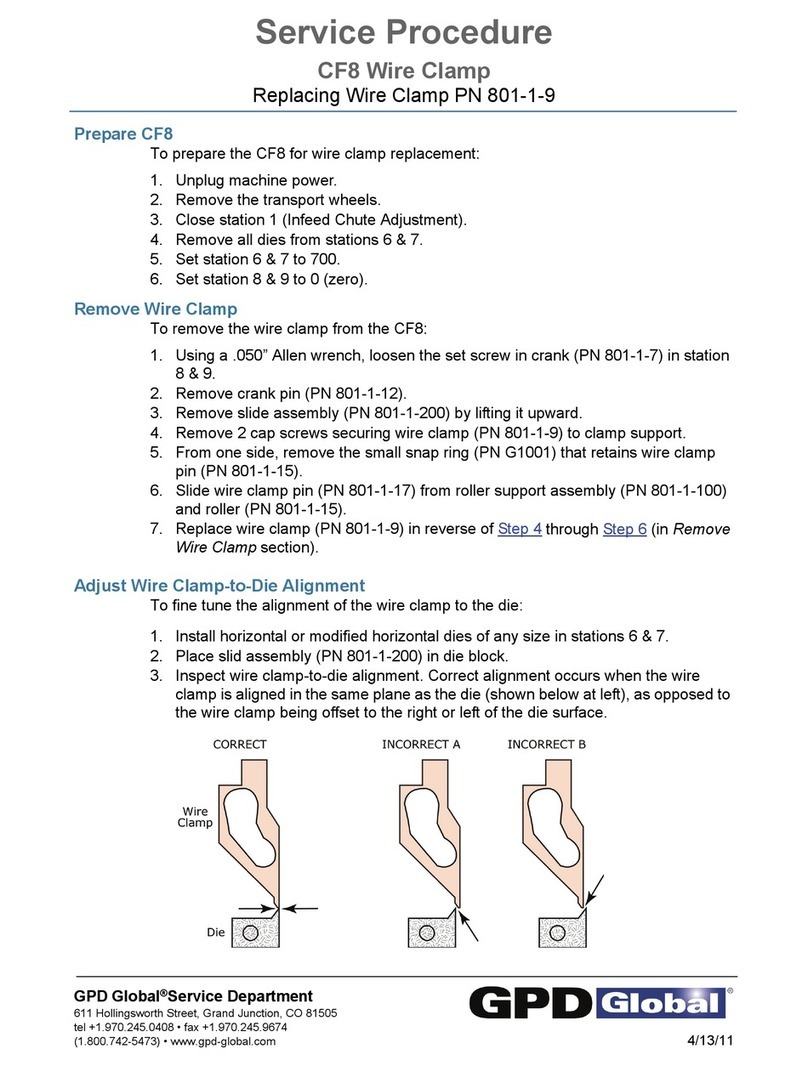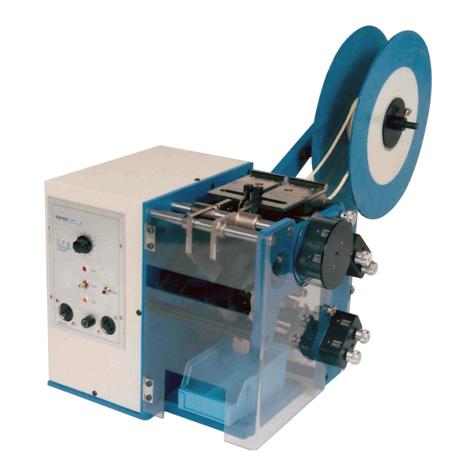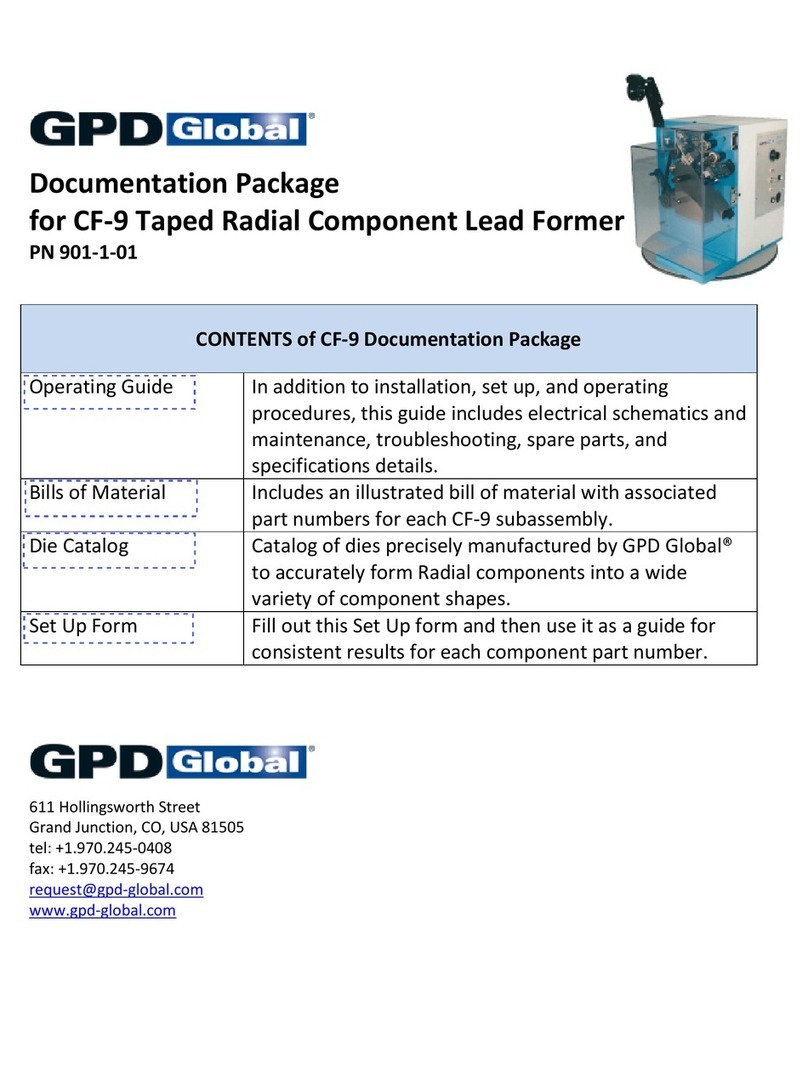GPD Global CF-8 User manual

CF-8 Set Up Gauge Instructions
Version 1.0
November 5, 2012
Part No: 801-1-04
611 Hollingsworth Street
Grand Junction, CO, USA 81505
tel: +1.970.245-0408 • fax +1.970.245-9674
Copyright © 2012 GPD Global®• All Rights Reserved

INDEX
PAGE
Timing the gears and pulleys
1
Counter bracket positioning
3
Setting the centre line of the machine 4
Setting the crimping die stations
5
Setting the bending die stations 6
Setting the magnets
7
Setting the transport wheel forks 8
Setting the cutting wheels
9
Setting the graduated shaft
11
Setting the crimping die stops
12
Aligning the forks
13
Setting the crimping die station stroke 14
Hetric Settings 15

Timing the gears and pulleys
The machine is timed and tested before leaving the factory. If however new
pulleys or belts are 'installed, the rear support plate is removed for any
reason, or any other adjustment that has altered the timing it may be retimed
by the following routine.
The machine when viewed from the front, (the adjustment knobs for D's
I, 4, 5,
6&7 facing you) all keyways to be facing in the upward position, except one.
That being the pulley that drives the crimping dies. This keyway is at
approximately
17 - 18
degrees in the clockwise direction as shown in Fig. 1.
re
------- '~
(9
. 0
(17-18)
Fig. 1
The square shaft location when viewed at this setting should be as in Fig. 2,
with the flat in one corner as indicated. The spring plunger which locates
the shaft when in this position can be seen to be facing upwards. This
plunger is between the main upright and rear support plate.
(
I
Fig. 2
If the keyways do not appear to be in the upward position the machine can
be turned through a few cycles until it is. This keyway pattern repeats
itself once in every six revolutions of the main gear, Part
#803-1-12.
If
the keys or keyways are not always visible the set screws which locate on
top of the keys can be seen in the upright position. To get the keyways
into position it will be necessary to turn the driven shaft by hand while
the cutting wheel is stationary.
- 1 -

With a component in the transport wheels the component lead should be in the
centre of the roller as shown in Fig.
3,
or centre of the pad in Fig.
4
(same
position) , depending on which is easiest to check. This is most easily located
by turning the machine one position back and then moving forward into this
position. If it is in the position the timing is correct and if the other
settings have been made it is ready to operate.
,
Fig. 3 Fig. 4
If the transport wheel is not in the position it can be advanced or retarded
by loosening the two screws that hold the idler gear and moving the bracket
that supports the gear. In doing this the component in the transport wheel
moves forward or backward until it is in the position shown in Fig. 3 &4.
Tighten the screws again with minimum back-lash between the gears in the
correct position and the machine is timed. After tightening, check that it
did not move whilst being tightened. The idler gear could be one of two
types as shown in Fig. 5 &6.
Fig. 5 Fig. 6
/~
/
/
/
~/
- 2 -

Counter bracket positioning
The tapped hole alignment block is required when installing infeed chutes
and bulkfeeder support block shaft, part #809-4-19A. The 8-32 caphead
locates the counter positioning block on the shaft as shown in Fig. #7.
Set the block in the horizontal position and up against the main frame
upright. In this position the tapped hole is set perpendicular to the
base and the correct distance from the upright to locate the counter
bracket. When in this position tighten the two set screws, part #SS1032025
to locate these shafts permanently. (Remove alignment block when setting
is completed).
Fig. 7
- 3 -

Setting the centre line of the machine
The cen.tralposition of the machine is established with the main set-up
gauge. This is .achieved by locating on the infeed chute and bulkfeeder
support blocks. The four 1/8" holes in the gauge locate on four dowels
in support blocks (2 in each), by turning the
III
adjustment knob until
,
the gauge just slips into place without any forcing or pushing. The two
1/4 - 20 set screws clamp the gauge to the blocks. The shaft which
protrudes from one side of the gauge is then set to .010" from the upright
by adjusting the ball retaining screw and lock-nut as shown in Fig. 8.
'.
Fig. 8
-'~l
r
I
I
i
,
, I '
, : I
I
I)
~I
..•.
-4-

·Setting the crimping die stations.
Place the Lshaped bracket on the perpendicular shaft attached to main
set-up gauge, which will be through the middle of the machine. The 10-32
cap head screw will clamp the bracket in place as shown in Fig.
9.
Fig. 9
,-
J
-
I~
-
t:
:J
-
Place the two dummy die blocks market
4
& 5 set up in the #4 & #5 die holders.
Make sure that they are set in the top position, (the fixed die holder casting).
Tighten with the screws, part #801-1-19 that locate the dies when the machine
is is use. (The crimping die stop brackets, part #818-1-11 L&R must be loose
or set out of the way at this point). Bring both the #4 & #5 stations towards
the centre of the machine. The perpendicular shaft on gauge will now be the
reference position. The dummy die blocks should be adjusted in until they are
set at .010" from the perpendicular gauge as shown in Fig. 10.
6
-\R0
@1L--Jlj
@
_ _Ji
A
I - ,---------
f
~-lil~)
1
1-~. .~
_.-. _J
t--' -
.010":''-.
1
---'1"'- ~I
When this position is achieved the counters for the #4 & #5 stations should
Fig. 10
be set at 00350. To set counters, turn the small gears on counter to the
desired setting. Slip the counter box over the two adjusting shafts and
align with the two larger gears on these shafts. Replace counter box screws
and tighten. Replace adjustment knobs on the protruding section of adjustment
shaft and tighten.
- 5 -

,Setting the bending die stations.
Place the second L shaped bracket on the perpendicular shaft the other way
around and between' the'bending stations
II's
6
&
7.
Clamp the bracket in
place with the 10-32 cap head screw as shown in Fig. 11.
J~I
L.. 1
Fig. 11
L -l
Place the two dummy die blocks marked
6
&
7
set-up in the appropriate die
holders and tighten with screws, part #801-1-19 that locate the dies when
the machine is in use. In order for the die blocks to enter the die holders
the machine must be turned to the position in which the wire clamp and
roller, part D's 801-1-9
&
801-1-11 are fully up (out of the way). Bring
both the #6
&
#7 station towards the centre of the machine. The perpendicular
shaft on gauge will again be the reference position. The dummy die blocks
should be adjusted in until they are set at .010" from the perpendicular
gauge as shown in Fig. 12.
Fig. 12
When this position is achieved the counters for the #6
&
#7 station should
be set at 00350. Set counters again as described in #4
&
#5 set-up.
Now with D's 4, 5, 6
&
7 counters all set the dummy die blocks may be
removed before proceeding with the next stage.
- 6 -

Setting the magnets.
Place the 1 z;"square on to the magnet between the perpendicular. shaft on
the main set-up gauge.as shown in Fig. 13.
Fig. 13
{
Move the square on the magnet in until it touches the perpendicular shaft,
as shown in Fig. 14.
Fig. 14
~
•.
il
I
I
In this position lock the two set screws OSS-8320188 which hold the magnet
in place via the rods from the magnet holder.
\
\
When this is completed repeat the same procedure on the other magnet on
the opposite side of the perpendicular shaft.
- 7 -

Setting the transport wheel forks.
Setting the forks is done by placing the two diameter disc in the forks
with the large diameter disc facing inwards. The fork can be brought
closer to the perpendicular shaft by loosening the self-locking nut on
the end of the shaft attached to the fork as shown in Fig. 15. (The
set screw that positions the direction of the fork must be loose). The
polyeurathane acts as a spring washer and takes up the play from any
movement that occurs.
Fig. 15
I
I
~
I
I
I
I
The setting for this is by rotating the discs by thumb until they touch
the perpendicular shaft and no longer rotate freely. Set this distance
so that the drag on both discs is equal. Do not lock the forks with the
set screw yet, as they have to be alig~ed with the square shaft later on
in the setting procedure (A wrench is supplied to hold the fork when the
self-locking nut is being adjusted).
- 8 -

Setting the cutting wheels
The position of the cutting wheels can be set when the wheels are in the
stationary position, using the 3/16" rod provided.
Insert the rod into two tooth spaces opposite each other on the cutting
wheels. Press down on the shaft so that it is firmly seated in the
cutting wheels and press back, so that both ends of the shaft are in
contact with the protruding arms of the setting gauge as shown in Figs.
16 &17. When in this position, .lock the cutting wheels by tightening the
six round head screws part #SR-832037, facing towards the centre of the
machine. (Three on each side). Remove the shaft when both wheels are set.
Fig. 16
Fig. 17
- 9 -

Setting the cutting ~heels (cont'd)
There are four set screws part USSI032025 in the hubs on the outside of
the cutting wheels (two in each). These ensure that the set position does
not,slip when in use. With the keyway on the cutting wheel shaft facing
down these screws are easily accessible as shown in the sketch below.
These screws should be just nipped tight as overtightening will result in
damage to the cutting wheels.
I
\
"
\ I"
I
I
I
I
, I
I
./
- 10 -

Setting the graduated shaft
The cutting wheels when being timed can be moved out using the
112
&
113
adjustment po~itions. Set the wheels to a .010 gap using a feeler gauge
between the inside of gauge and outside of cutting wheel as shown in
Fig~ 18. When the cutting wheels are in this position, the graduated
shaft can be set to read 1.5 in each window on the knife holders. When
the shaft is set equidistant with 1.5 on both scales, the two set screws
part IISS-I032025 in the upright and front plate at either end of this
shaft should be tightened.
I
I
I
I
~
I
I
___ i
Fig. 18
8
I ~~
.010"
L-- .... .._..~_ ..
- 11 -

Setting the crimping ,die stoI?~
To set the stops on the crimping die station, dial the settings on the
#4 & #5 stations to 00325. Move the crimping die stop bracket part
n
818-1-4L&R into contact with the cut out on the die stations as shown
in fig. 19. When in this position lock the four cap head set screws,
part
USC-832025
that hold the die stop brackets. (Two in each). This
setting now prevents the crimping .die stations from accidently damaging
the transport wheels when being adjusted.
Fig.
Q,
19
I
~©'
L__
I
I
I
I
I
i
I
.--
I
©
@
I
I
i
I
I
r
~~.
I
1-.:4-
1
h
;
b
~
I
I
I
I
:
I
i
i·1
I
I
(j
tr;,-~--~)
I
"
I
I
e Ie
;W
-~Ie~,j
r
i'
J
J
i
J
When the settings in Figs. 8 - 19 are completed. Remove the two L shaped
brackets from the perpendicular shaft and remove the two ~" caphead screws
holding the set-up gauge to the infeed chute and bulkfeeder support blocks.
The set-up gauge may now be lifted out of the machine.
- 12 -

Aligning the forks
Slip the brass hub over the square shaft and inset the square shaft into
its location position. (If one, or both of the forks is out of alignment
it may be necessary to move it up or down to enable the square shaft to go
betr-reenthe forks). Slide the brass hub down the shaft, and move forks up
and down again if necessary until the hub can slide freely between both
forks. To set forks in this position tighten the set screws, part #
SS-8320188 in the back of infeed block bracket part
ff818-1-SL&R
as shown
in Figs. 20
&
21.
Fig. 20
Fig. 21
;
.~
[li-""."'.~
I
I
1---..
_. /1
- 13 -

Setting the crimping die station stroke
The #4 &5 crimping die stations reach their closest setting at different
times and therefore must be set
Ln
dcpcndcn
t
Ly
at
UIC
closest
s
c
t
t
Ln g of
each. When in this position the gap bctween the two pads that locate the
(
dies is .837. The gap is set using the .837 size block with a handle
attached, as seen in Figs.
22
&
23
below. The handle allows relatively
easy access to an awkard position in the machine.
The adjustment on here is by rotating the eccentric bushing in the crank
arm that operates this station. The eccentric bushing has a hole in its
outside boss which can be adj usted with the use of a small allen key. When
the correct gap is set, the set screws part DSS6320188 should be tightened.
Repeat the same procedure for the other crimping die station when that is
at its closest setting.
o
Fig. 22 Fig. 23
, I
I~
II
LJ
I
I
.:
I
)
~O
11~
L
2
I
J
cQ_
- 14 -
i
\\
",,-----/'
.-
tJ
I
II
~-~"-
c~1
---
---
---
.
--\
@) /
cs: \

For the machines with metric readings the counters should be set at the
figures, given below.
Imperial Metric
Page
S
#4
&
S 003S0
00089
Page 6 #6
&
#7
00350
00089
Page
11
#2
&
#3
01500
00381
Page 12 #4
&
5 00325
00083
The part # changes from imperial to metric are shown in the list
below:
Exploded View # Imperial Metric
801-3-0E
802-1-5
802-1-sM
&
802-3-0E 802-1-6 802-1-6M
803-2-0E 803-1-4 803-1-4M
"
803-1-S 803-1-SM
809-s-0EA
809-4-8 809-4-8M
813-1-0E 813-1-1 813-1-1M
"
813-1-2 813-1-2M
- 15 -

CF 8 SET-UP SEQUENCE
1. KNIFEHOLDER SEQUENCE AND CHECK
A. OPEN KNIFEHOLDER POSITIONS TO .SOO' IN STATION'S 2 AND 3,
AS VIEWED ON THE GRADUATED SHAFT.
B. OP.EN CRIMPING STATIONS IN COUNTER POSITION'S 4 AND 5 TO 01.000".
C. OPEN BENDING STATIONS IN COUNTER POSITIONS
6
AND
7
TO
01.000".
D. OPEN INFEED CHUTES_UNTIL~~HE~GRIMEIUG STATIONS STOP.
E. CHECK KNIFEHOLDERS FOR WEAR.
UTILIZING A
.010"
SHIM CHECK THE GAP BETWEEN THE CUTTING BLADE
AND THE CUTTING WHEEL.
IF THE GAP IS
.010"
OR GREATER, THE KNIFEHOLDER SHOULD BE REPLACED.
CHECK THE CUTTING BLADES. (REVERSE THEM ON A MONTHLY BASIS).
2. REMOVE KNIFEHOLDER AND CLEAN.
fL
COUNTER BRACKET POSITIONING. PAGE
3.
4.
SETTING THE CF 8 CENTERLINE. PAGE
4.
5. SETTING THE CRIMPING STATIONS. PAGE 5.
6.
SETTING THE BENDING DIE STATIONS. PAGE
6.
7. SETTING THE MAGNET ASSEMBLY. PAGE
7.
8. SETTING THE TRANSPORT WHEEL FORKS. PAGE 8.
9.
SETTING THE CUTTING \mEELS. PAGE
9.
10.
INSTALLING THE KNIFBHOLDERS.
11.
SETTING THE GRADUATED SHAFT. PAGE
11.
12.
SETTING TIlE CRUfPING DIE STOPS. PAGE
12.
13.
ALIGNING THE FORKS. PAGE
13.
14.
SET[ING THE CRIMPING DIE STATION STROKE. PAGE
14.

Installation Procedure for
#2 & #3 Station Counters on CF-8

Position of #2  Station
Turn the machine to the position where the keyway in the main shaft
part #803-1-1 is facing up and the adjustment plate for the #2 
station are in the position as shown in Fig.
1.
Fig. 1
f1~.--,--
,/'
I I
I
I
ct
-r--T
Ll
I
'I
..- LJ"
====::L.,
L
~
~
,
I
I
I
I
I
t5
i
II
I
P
i
II
'-'
I
Ii
'r"
i
1:0'
- 1 -
Other manuals for CF-8
2
Table of contents
Other GPD Global Industrial Equipment manuals




















